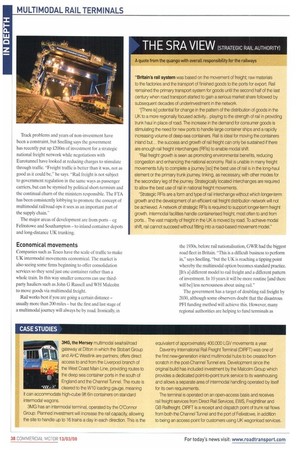After years of decline in rail freight, growing numbers of
Page 37

Page 38

Page 39

If you've noticed an error in this article please click here to report it so we can fix it.
multimodal rail terminals have been appearing in the UK during the past decade. As container companies increasingly link up with worldwide shippers, road is often the beginning and end of a journey in which the long-distance leg is undertaken by rail or boat.
This is not news on the Continent where intermodal transport is firmly established, largely because of the ability to travel vast distances and across national borders without using ferries. In crowded, island Britain rail scores environmental brownie points, but suffers from endemic infrastructural difficulties: poor links with the Continent, network capacity priority given to passengers and the antipathy of a succession of governments — Margaret Thatcher's dislike was legendary — to rail investment over the past 50 years.
The head of rail freight and multimodal policy at the Freight Transport Association (FTA), Christopher Snelling, says there has been a resurgence in road/rail freight in recent years, driven in no small part by environmental criteria and board-level decisions, for example from customers such as large retailers. "People are at the very least examining the idea," he says. There will always be tension between short-term political advantage and long-term capital investment, Snelling adds, but currently traditional bulk freight volumes are steady while container and multimodal freight is growing.
PerishabLe traffic
The key recent paradigm shift illustrated by the Tesco/ Stobart link — demonstrates road/rail's ability to handle time-sensitive perishable traffic rather than just bulk raw materials. The genesis of this, according to Snelling, goes back 10 years to rail privatisation.
He concedes this had mixed results for passengers hut claims it liberated the rail market in advance of the position on the Continent. "(We have) private investment and a dynamic customer-oriented culture actually looking for business rather than just supplying capacity like the old nationalised freight network." Track problems and years of non-investment have been a constraint, but Snelling says the government has recently put up /200m of investment for a strategic national freight network while negotiations with Eurotunnel have looked at reducing charges to stimulate through traffic. "Freight traffic is better than it was, not as good as it could be," he says. "Rail freight is not subject to government regulation in the same ways as passenger carriers, but can be stymied by political short-termism and the continual churn of the ministers responsible. The FTA has been consistently lobbying to promote the concept of multimodal rail/road ops it sees as an important part of the supply chain."
The major areas of development are from ports eg Felixstowe and Southampton to inland container depots and long-distance UK tninking.
Economical movements
Companies such as Teseo have the scale of traffic to make UK intermodal movements economical. The market is also seeing some firms beginning to offer consolidation services so they send just one container rather than a whole train. In this way smaller concerns can use thirdparty hauliers such as John G Russell and WH Malcolm to move goods via multimodal freight.
Rail works best if you are going a certain distance usually more than 200 miles but the first and last stage of a multimodal journey will always be by road. Ironically, in the 1930s, before rail nationalisation, GWR had the biggest road fleet in Britain. "This is a difficult business to perform in," says Snelling, "but the UK is reaching a tipping point whereby the multimodal option becomes standard practice. [It's a] different model to rail freight and a different pattern of investment. In 10 years it will be more routine [and there will be] less nervousness about using rail."
The government has a target of doubling rail freight by 2030, although some observers doubt that the disastrous PFI funding method will achieve this. However, many regional authorities are helping to fund terminals as part of their economic development responsibilities.
The use of rail is likely to complement road, not replace traditional haulage, especially in moving containers. It also offers at least some help with issues such as easing traffic jams, avoiding congestion charging, reducing emissions and moving container distribution depots inland away from expensive, overcrowded ports.
Trucks running shorter distances might be more suitable for double-shifting, and drivers wouldn't suffer so much from the lack of decent overnight parking facilities.
"This is a good time for rail freight," says Snelling, "the environmental agenda is here to stay." •
CONTACTS www.3-mg.co.uk/raiLaspx www.dirft.com
www.freightonrail.org.uk Lobby group including Network Rail, Transport 2000 and trade unions www.multimodal.org.uk April 2008 exhibition at NEC www.tfl.gov.uk see Rail Freight Strategy document www.ahcwarehousing.co.uk/rail.html. AHC Westlink www.dft.gov.uk/pgr/freight/railfreight/strategicrail freightintercha3222 NT strategy abports.co.uk/custinfo/ports/swansea/facilities.htm www.eddiestobart.co.uk
www.malcolmgroup.co.uk www.johngrussell.co.uk www.cartwright-group.co.uk www.roadways.co.uk www.fta.co.uk








































































































































































